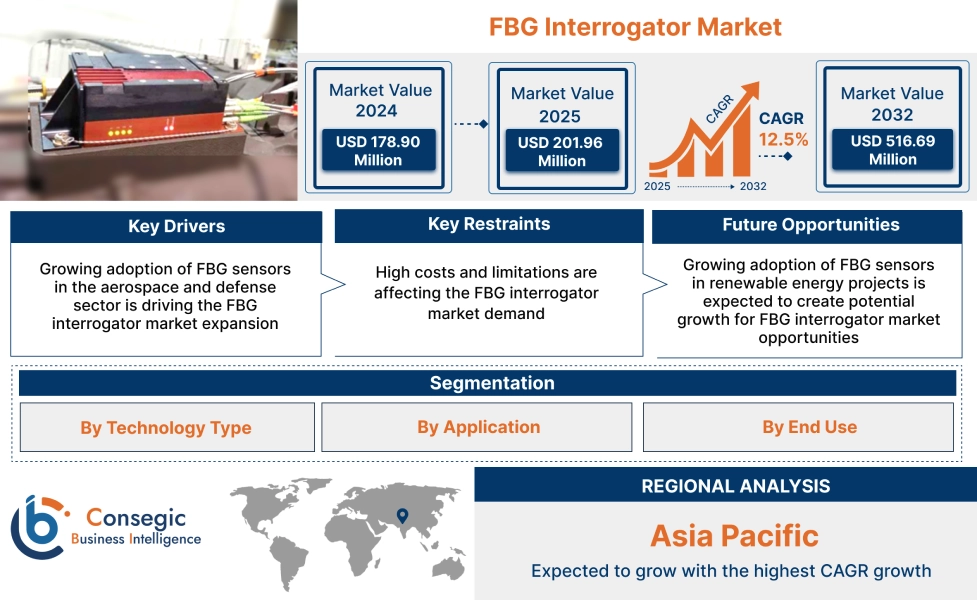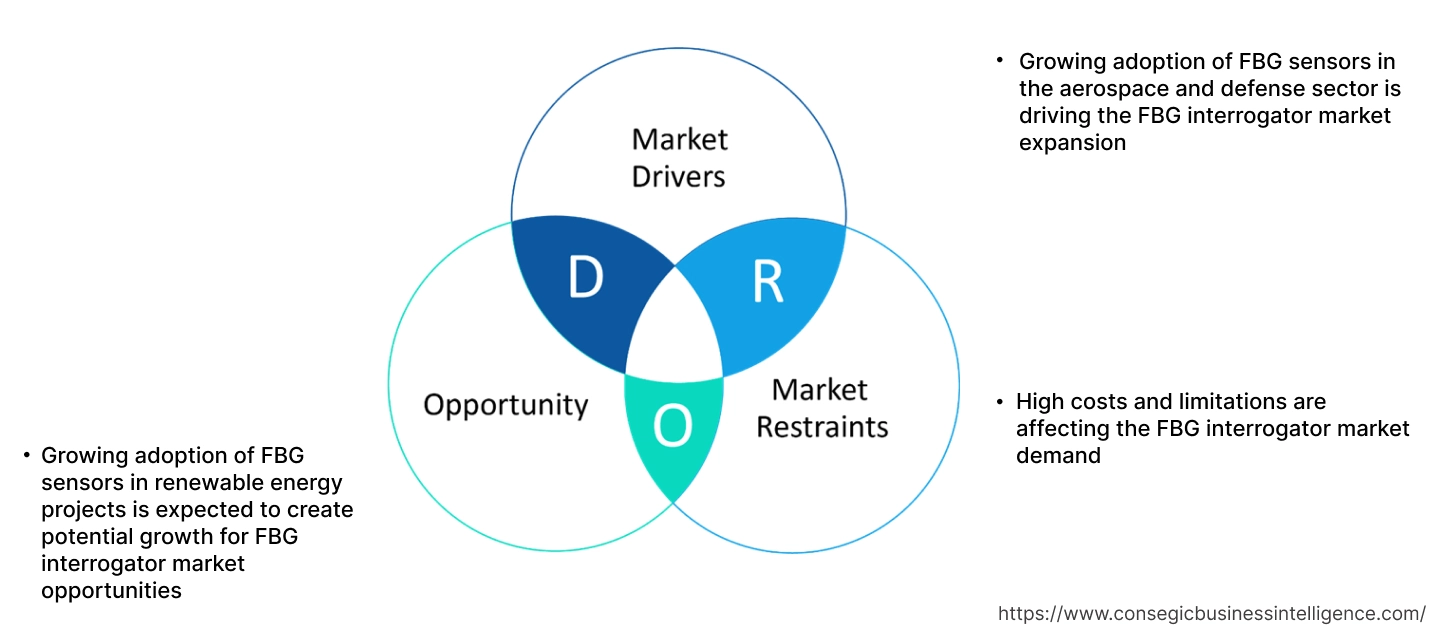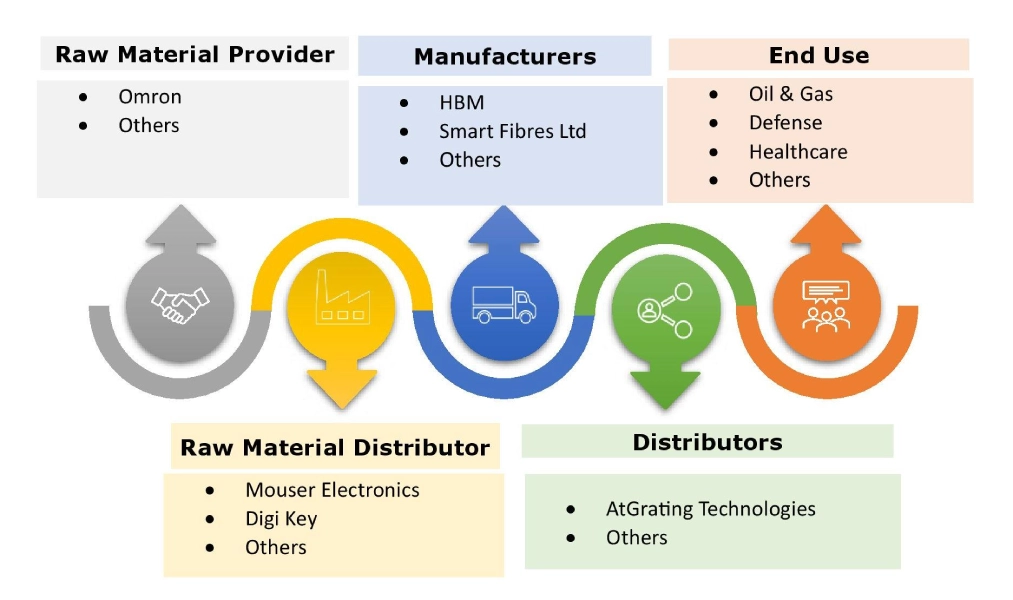FBG Interrogator Market Size:
FBG Interrogator Market Size is estimated to reach over USD 516.69 Million by 2032 from a value of USD 178.90 Million in 2024 and is projected to grow by USD 201.96 Million in 2025, growing at a CAGR of 12.5% from 2025 to 2032.
FBG Interrogator Market Scope & Overview:
An FBG interrogator is an optoelectronic device used to read and analyze data from fiber bragg grating (FBG) sensors. It essentially sends light into the FBG fiber, captures the reflected light, and converts it into an electronic signal representing the sensor's data. This data can then be used to measure various properties like temperature, strain, or other changes in the environment where the FBG sensor is placed.
How is AI Transforming the FBG Interrogator Market?
AI is transforming the FBG (Fiber Bragg Grating) interrogator market by advancing precision, automation, and predictive insights. FBG interrogators, used for monitoring strain, temperature, and pressure in industries like aerospace, energy, and civil engineering, are now enhanced with AI-driven analytics. AI processes vast sensor data in real time, improving accuracy and filtering out noise for more reliable measurements. Whereas, machine learning models can predict structural stress or potential failures, enabling proactive maintenance and reducing risks in critical infrastructure. AI also supports remote monitoring and automated calibration, ensuring consistent performance with minimal human intervention. As industries demand smarter sensing solutions, AI is making FBG interrogators more intelligent, efficient, and vital for safety-critical applications worldwide.
FBG Interrogator Market Dynamics - (DRO) :
Key Drivers:
Growing adoption of FBG sensors in the aerospace and defense sector is driving the FBG interrogator market expansion
FBG sensors are extensively used for structural health monitoring, strain measurement, and vibration analysis in aircraft and defense systems. The emphasis on safety, reliability, and predictive maintenance in the aerospace & defense sector is leading to increased investment in FBG sensor technology. The aerospace sector’s continuous innovation and the rising need for advanced monitoring systems are further propelling the market forward.
Further, there is a strong drive towards smaller, more compact, and portable FBG interrogator systems. Advancements in photonic integrated circuits (PICs) are playing a crucial role, leading to the rising need for interrogators that are robust, cost-effective, and suitable for space-constrained applications, including integration into small, portable devices or unmanned aerial vehicles (UAVs).
- For instance, Smartfibers’ SmartScan Aero Mini is a highly compact and durable device designed to precisely measure fiber Bragg grating (FBG) sensors in dynamic environments. This WDM (wavelength division multiplexing) interrogator utilizes a flexible, tunable laser to achieve high-resolution readings at multi-kilohertz speeds. It has successfully met military standard environmental qualifications and is currently operational on military aircraft.
Thus, according to the FBG interrogator market analysis, the growing adoption of FBG sensors in the aerospace and defense sector is driving the FBG interrogator market size and trends.
Key Restraints:
High costs and limitations are affecting the FBG interrogator market demand
The initial investment required for installing these sensors and the costs involved in maintaining and calibrating them can be significant, particularly for small and medium-sized enterprises. This cost factor can act as a barrier to the widespread adoption of FBG sensors, thereby limiting their market penetration. Additionally, the availability of alternative sensing technologies at a lower cost can also pose a threat to the growth of the market. Therefore, the aforementioned factors would further impact the FBG interrogator market.
Future Opportunities :
Growing adoption of FBG sensors in renewable energy projects is expected to create potential growth for FBG interrogator market opportunities
The transition towards renewable energy sources, such as wind and solar power, necessitates advanced monitoring solutions to ensure the optimal performance and efficiency of energy systems. FBG sensors are employed in monitoring wind turbine blades, solar panels, and other critical components, providing valuable data for predictive maintenance and operational optimization. The increasing investments in renewable energy projects and the emphasis on sustainable energy solutions are expected to drive the need for FBG sensors, creating substantial growth prospects in this sector.
- For instance, in September 2024, Sentea developed a single-chip FBG read-out system, which is suitable for the energy sector. In the energy sector, these sensors will allow for better monitoring of wind. This will lead to enhanced safety, extended lifespans, and more efficient capacity utilization. This strategic innovation is expected to boost the growth of the FBG interrogator market share.
Thus, based on the above FBG interrogator market analysis, the above factors are expected to drive the FBG interrogator market opportunities and trends.
FBG Interrogator Market Segmental Analysis :
By Technology Type:
Based on technology type, the market is segmented into optical time domain reflectometry (OTDR), optical frequency domain reflectometry (OFDR), fiber bragg grating (FBG) sensors, and multimode and singlemode interrogators.
Trends in the technology type:
- There is a growing need for compact systems in remote monitoring, mobile platforms, and distributed sensor networks where space and power are critical constraints.
- The rising need for sophisticated predictive maintenance, autonomous decision-making in smart systems, and the overall shift towards Industry 4.0 and smart infrastructure are further driving the FBG interrogator market growth.
- Thus, based on the above analysis, these factors are driving the FBG interrogator market demand and trends.
The fiber bragg grating (FBG) sensors segment accounted for the largest revenue share of 42.45% in the year 2024.
- These sensors offer high accuracy and stability, making them suitable for applications in the aerospace, energy, and healthcare sectors. The ability to withstand harsh environmental conditions further accentuates their importance.
- The increasing focus on infrastructure development and the need to maintain aging structures are driving the need for sensors.
- Moreover, these sensors are also employed in the automotive and aerospace industries for monitoring stress and strain in vehicles and aircraft components.
- For instance, ICON’s SwitchedGator is a compact, 8-channel interrogator designed for widespread FBG sensing. It has a small physical dimension of 110 × 130 × 47 mm, operates on a low power of 12 VDC/5W, and offers an IP67 mounting option for durability.
- Thus, based on the above analysis, these factors are driving the FBG interrogator market share and trends.
The optical frequency domain reflectometry (OFDR) segment is anticipated to register the fastest CAGR during the forecast period.
- The development of the segment is driven by the increasing need for advanced fiber optic network systems, which are essential for supporting the expanding internet infrastructure and high-speed data transmission requirements worldwide.
- The deployment of 5G networks, which require extensive fiber optic infrastructure, is another major growth factor, as it necessitates precise and reliable testing of optical fibers to ensure network efficiency and reliability.
- The industrial sector is also contributing to the development of the optical reflectometers segment.
- Industries are increasingly adopting automation and IoT solutions, which involve extensive use of fiber optics for communication and data transfer.
- The above factors are further driving the FBG interrogator market growth and trends.

By Application:
Based on application, the market is segmented into optical sensors, ultrafast dynamics (dispersion compensation, gain flattening, add/drop), tunable lasers, spectrometers, data logging, structural health monitoring (SHM), industrial R&D and industrial test, medical equipment, and others.
Trends in the application:
- The growing investments in transportation infrastructure and the emphasis on enhancing the safety and efficiency of transportation systems are expected to drive the adoption of FBG interrogators.
- As governments and private entities invest in smart city projects and infrastructure development, the need for precise and reliable monitoring solutions is rising. FBG sensors, with their high sensitivity and ability to provide real-time data, are well-positioned to play a crucial role in the development and maintenance of smart infrastructure, offering significant growth potential for market players.
- Based on the above analysis, these factors are anticipated to further drive the FBG interrogatormarket trends and demand during the forecast period.
The structural health monitoring (SHM) segment accounted for the largest revenue in the year 2024 and it is expected to register the highest CAGR during the forecast period.
- FBG SHM provides the real-time, precise data needed to make informed maintenance decisions, extend asset lifespans, and reduce unexpected downtime and repair costs.
- The increasing use of lightweight, high-strength composite materials in aerospace, wind energy, and automotive industries is driving the market. These materials often exhibit complex failure modes that are difficult to detect with traditional sensors. FBG sensors can be embedded within these materials during manufacturing without significantly affecting their properties.
- Moreover, the stringent safety regulations and the public demand for increased safety in critical infrastructure, such as bridges, aircraft, high-speed trains, and others, are driving the need for more robust and continuous monitoring.
- Thus, based on the above analysis, these factors would further supplement the FBG interrogator market trends.
By End Use:
Based on end use, the market is segmented into oil & gas, telecommunications, healthcare, defense, industrial, and others.
Trends in the end use:
- With the global push towards smart cities and increasing investments in intelligent transportation systems, there is a significant demand for advanced monitoring solutions.
- The integration of FBG sensors in smart infrastructure projects can lead to improved safety, efficiency, and sustainability, in turn creating a substantial market opportunity.
The oil & gas segment accounted for the largest revenue in the year 2024 and it is expected to register the highest CAGR during the forecast period.
- In the oil & gas sector, these sensors are intensely utilized for monitoring the health of pipelines, drilling rigs, and sub-sea equipment.
- The harsh operational conditions and the critical need for ensuring safety and operational efficiency have led to the widespread adoption of FBG sensors in this industry.
- As exploration activities continue to expand and the focus on minimizing environmental impact heightens, the demand for advanced sensing solutions in oil & gas is expected to grow strongly.
- For instance, AtGrating’s FBG sensors are used in offshore oil platforms, oilfields, and coalfields for monitoring reserves and geological conditions. Furthermore, FBG sensing systems can provide continuous, real-time online monitoring of extensive oil and gas pipelines.
- Thus, the above factors and developments are driving the global market.
Regional Analysis:
The global market has been classified by region into North America, Europe, Asia-Pacific, Middle East & Africa, and Latin America.
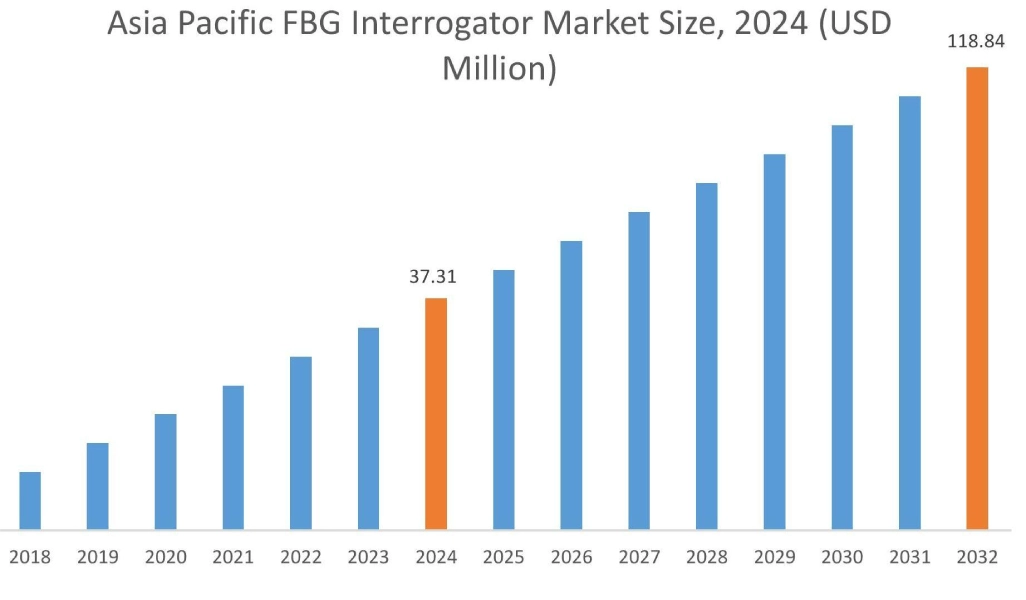
Asia Pacific FBG interrogator market expansion is estimated to reach over USD 118.84 Million by 2032 from a value of USD 37.31 Million in 2024 and is projected to grow by USD 42.48 Million in 2025. Out of this, the China market accounted for the maximum revenue split of 30.74%. The rapid industrialization, coupled with the growing investments in infrastructure development and telecommunication networks, is driving the demand for FBG interrogators in the region. Countries in the region are leading the market development with significant applications of FBG sensors in transportation, energy, and telecommunications sectors. Further, the government's initiatives to promote smart city projects and renewable energy sources are creating lucrative prospects for market development. Hence, the above factors would further drive the regional FBG interrogator market during the forecast period.
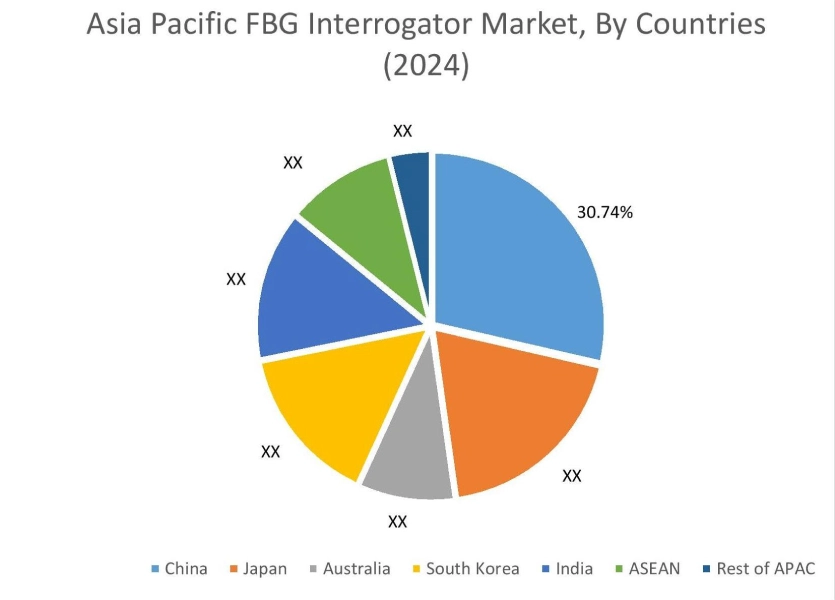
The North American market is estimated to reach over USD 208.23 Million by 2032 from a value of USD 72.23 Million in 2024 and is projected to grow by USD 81.62 Million in 2025. North America is expected to hold a significant share of the market, driven by the region's strong technological infrastructure and high adoption rates of advanced sensing technologies. The United States is a major contributor to the market development, with extensive applications of FBG sensors in the aerospace, defense, and telecommunications sectors. Further, the ongoing investments in infrastructure development, coupled with the emphasis on enhancing safety and reliability in various industries, are propelling the need for FBG sensors in the region. These factors would further drive the regional market share during the forecast period.
- For instance, in June 2023, the U.S. Federal Government allocated around USD 42.5 Million, through the National Telecommunications and Information Administration's Broadband Equity, Access, and Deployment program, to improve broadband internet access across the nation. The above factors are projected to drive the market in North America.
Additionally, according to the analysis, the FBG interrogator industry in Europe is expected to witness significant development during the forecast period. The region's commitment to renewable energy projects and smart infrastructure development is driving the need for advanced sensing solutions. Additionally, Latin America’s growing renewable energy projects and smart infrastructure development are driving the need for advanced sensing solutions.
The oil and gas sector remains a primary driver for FBG interrogator adoption in the Middle East and African regions. FBG sensors offer supreme advantages for monitoring well integrity, pipeline networks (for leaks, strain, and temperature), subsea equipment, and refinery processes in harsh, corrosive, and high-pressure environments where traditional electronic sensors fail or pose safety risks due to electromagnetic interference. These factors are driving the regional FBG interrogator market size and share.
Top Key Players and Market Share Insights:
The global FBG interrogator market is highly competitive with major players providing solutions to the national and international markets. Key players are adopting several strategies in research and development (R&D), product innovation, and end-user launches to hold a strong position in the market. Key players in the FBG interrogator industry include-
- Alnair Photonics Sdn Bhd (Malaysia)
- HBM (Germany)
- DK Photonics Technology Limited (China)
- INFIBRA TECHNOLOGIES (Italy)
- ICON Technologies (Australia)
- Polytec GmbH (Germany)
- Optics11 Life (Netherlands)
- Smart Fibres Ltd (U.K.)
- IDIL Fibers Optiques (France)
- Vutec Corporation's (U.S.)
FBG Interrogator Market Report Insights :
| Report Attributes | Report Details |
| Study Timeline | 2019-2032 |
| Market Size in 2032 | USD 516.69 Million |
| CAGR (2025-2032) | 12.5% |
| By Technology Type |
|
| By Application |
|
| By End Use |
|
| By Region |
|
| Key Players |
|
| North America | U.S. Canada Mexico |
| Europe | U.K. Germany France Spain Italy Russia Benelux Rest of Europe |
| APAC | China South Korea Japan India Australia ASEAN Rest of Asia-Pacific |
| Middle East and Africa | GCC Turkey South Africa Rest of MEA |
| LATAM | Brazil Argentina Chile Rest of LATAM |
| Report Coverage |
|
Key Questions Answered in the Report
How big is the FBG interrogator Market? +
FBG interrogator Market Size is estimated to reach over USD 516.69 Million by 2032 from a value of USD 178.90 Million in 2024 and is projected to grow by USD 201.96 Million in 2025, growing at a CAGR of 12.5% from 2025 to 2032.
Which is the fastest-growing region in the FBG interrogator Market? +
Asia-Pacific is the region experiencing the most rapid growth in the market.
What specific segmentation details are covered in the FBG interrogator report? +
The pass-by noise testing report includes specific segmentation details for technology type, application, end use, and region.
Who are the major players in the FBG interrogator Market? +
The key participants in the market are Alnair Photonics Sdn Bhd (Malaysia), HBM (Germany), Polytec GmbH (Germany), Optics11 Life (Netherlands), Smart Fibres Ltd (U.K.), IDIL Fibers Optiques (France), Vutec Corporation's (U.S.), DK Photonics Technology Limited (China), INFIBRA TECHNOLOGIES (Italy), ICON Technologies (Australia), and others.
